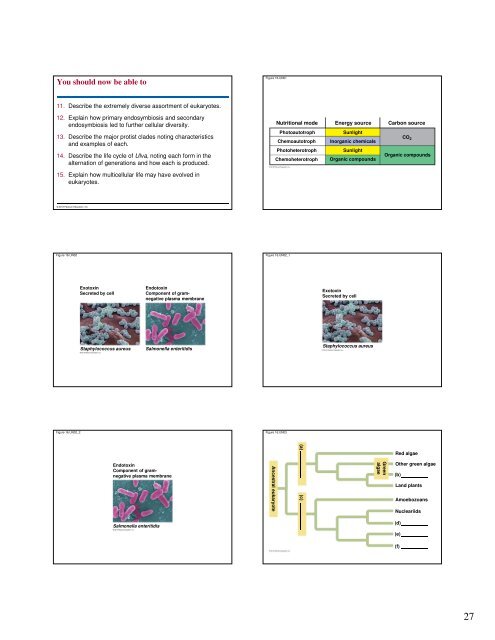Microbial Life: Prokaryotes and Protists - Renz Science
Microbial Life: Prokaryotes and Protists - Renz Science
Microbial Life: Prokaryotes and Protists - Renz Science
Create successful ePaper yourself
Turn your PDF publications into a flip-book with our unique Google optimized e-Paper software.
You should now be able toFigure 16.UN0111. Describe the extremely diverse assortment of eukaryotes.12. Explain how primary endosymbiosis <strong>and</strong> secondaryendosymbiosis led to further cellular diversity.13. Describe the major protist clades noting characteristics<strong>and</strong> examples of each.14. Describe the life cycle of Ulva, noting each form in thealternation of generations <strong>and</strong> how each is produced.15. Explain how multicellular life may have evolved ineukaryotes.Nutritional mode Energy source Carbon sourcePhotoautotrophSunlightChemoautotrophPhotoheterotrophInorganic chemicalsSunlightCO 2Organic compoundsChemoheterotroph Organic compounds© 2012 Pearson Education, Inc.Figure 16.UN02Figure 16.UN02_1ExotoxinSecreted by cellEndotoxinComponent of gramnegativeplasma membraneExotoxinSecreted by cellStaphylococcus aureusSalmonella enteritidisStaphylococcus aureusFigure 16.UN02_2Figure 16.UN03EndotoxinComponent of gramnegativeplasma membraneAncestral eukaryote(a) (c)GreenalgaeRed algaeOther green algae(b)L<strong>and</strong> plantsAmoebozoansNucleariidsSalmonella enteritidis(d)(e)(f)27


